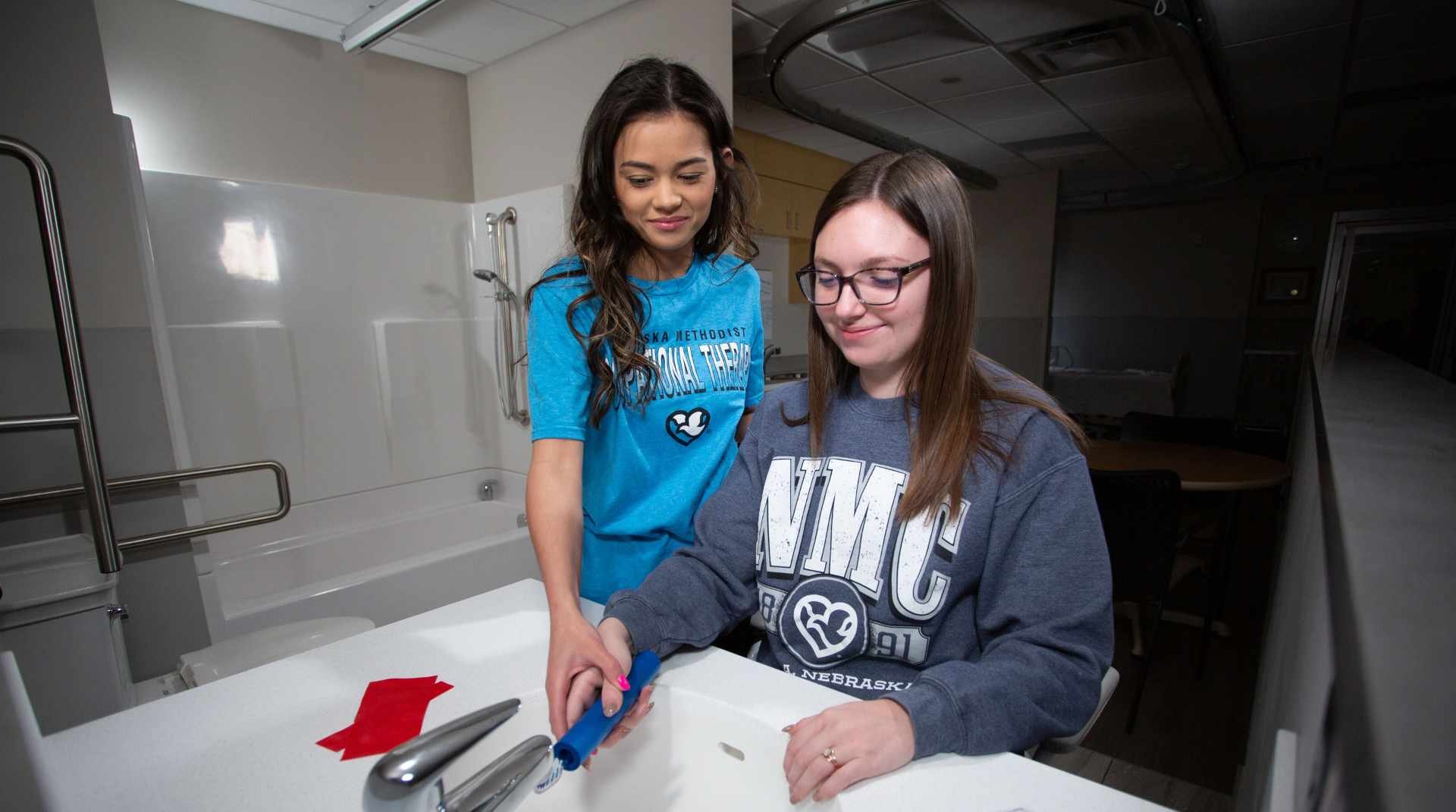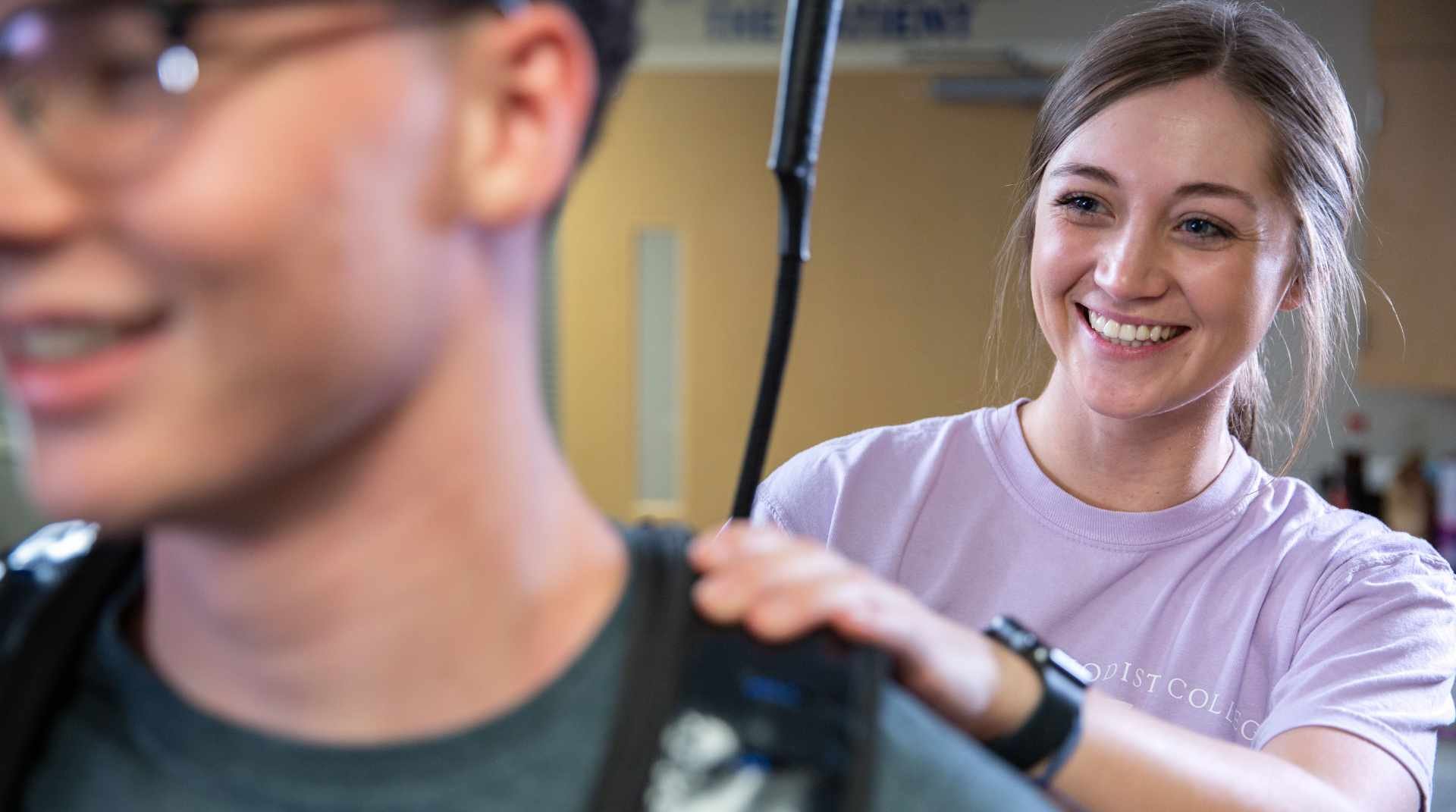 Helping someone regain strength or mobility after an accident or illness is incredibly rewarding.
Helping someone regain strength or mobility after an accident or illness is incredibly rewarding.
Occupational therapy (OT) and physical therapy (PT) focus on improving patients’ overall well-being. But there are important differences between the professions.
Nebraska Methodist College (NMC) offers an associate’s degree as a physical therapist assistant (PTA) and a master's degree in occupational therapy (OT).
As you’re planning your career in allied health, you’ll need to know the difference between PT and OT.
Occupational Therapist vs. Physical Therapist: An Overview
While there are similarities between the roles of physical therapists and occupational therapists, there is a distinct focus of each profession.
Physical therapists primarily address movement and physical function, while occupational therapists focus on improving daily activities and promoting independence.
Both physical therapists and occupational therapists collaborate with other healthcare professionals to provide comprehensive care to their patients.
Additionally, they play a vital role in educating patients and their families on injury prevention, self-care techniques and strategies for managing chronic conditions.
 Occupational Therapy: Key Tasks of an Occupational Therapist
Occupational Therapy: Key Tasks of an Occupational Therapist
An occupational therapist doesn't focus on one issue, rather, they treat the person as a whole.
Occupational therapists focus on helping individuals improve their ability to perform daily activities and tasks.
They work with patients of all ages who may have physical, cognitive, or emotional limitations that affect their independence.
They use a holistic approach to see how someone's activity has been affected as well as their roles and environment. Occupational therapy focuses on wellness promotion, rehabilitation and habilitation. A patient's well-being is supported in all aspects of their lives, including social, emotional and physical.
Occupational therapists assess a patient's abilities and develop interventions to enhance their skills in areas such as self-care, work and leisure activities. Rehabilitation methods in occupational therapy include adaptive equipment or modifications to the patient's environment to facilitate independence.
Physical Therapy: Role and Responsibilities of a Physical Therapist
A physical therapist and physical therapist assistant are crucial in treating a patient's movement and physical capabilities.
A PT is responsible for preventing injuries and getting patients back to their optimum motion while preventing further injuries and impairments. Treatment from a physical therapist can negate the need for surgery or further treatment.
Physical therapists work closely with patients to develop personalized treatment plans that focus on improving mobility, reducing pain and restoring function.
They use a variety of techniques such as exercise, manual therapy and specialized equipment to help patients regain strength and flexibility. Additionally, physical therapists educate patients on proper body mechanics and provide guidance on preventing future injuries.
Read more: What Does a Physical Therapist Assistant Do?
OT vs PT Degree Requirements
The minimum and preferred education requirement for PTAs is an associate degree.
NMC’s physical therapist assistant Associate of Science program can be completed in 21 months.
Students learn how to train patients to use crutches, canes and walkers. They also learn about massage therapy, mobility development, pain management, modality use, and how to use ultrasound and electrical stimulation.
Students get hands-on learning experiences by practicing with classmates and volunteers.
Physical therapist assistant clinical experience is also an integral part of the program. Working in a clinical environment provides real-life experience to hone skills in therapy, patient interaction and communication.
The physical therapist assistant program is ideal for recent high school graduates that want to start a career quickly. The program is also a natural step for someone with a bachelor’s degree in exercise science.
To become a physical therapist, a Doctor of Physical Therapy is required to enter the occupation. A doctorate can take seven or more years. One year of clinical residency is required after graduation
Read more: How to Become a Physical Therapist Assistant
A master’s degree in occupational therapy is the minimum education level required to take the licensure exam and practice as an occupational therapist. This education path allows you to learn the technical and personal skills necessary to provide effective and compassionate care to patients.
The Master of Occupational Therapy (MOT) program at NMC provides classroom learning, research assignments, lab work and clinical experience. The program is delivered in a hybrid format of on-campus and online instruction.
The MOT program can be completed by a full-time student within two years (six semesters).
Read more: Top 10 Tips for a Successful OTCAS Application
Personal Attributes: Essential Skills and Qualities for Success in PT and OT
If you’ve been thinking about a career in physical therapy or occupational therapy, you’ll want to consider whether you have the following attributes:
- A desire to help people improve their overall well-being and quality of life.
- The ability to work with diverse populations.
- Empathy and compassion.
- Clear communication skills.
- The ability to be flexible.
- Critical thinking and problem solving skills.
- A clear understanding of anatomy and physiology.
Read more: PTA Program Natural Step for Exercise Science Majors
Occupational Therapist vs Physical Therapist Work Environment
Physical therapists, physical therapist assistants and occupational therapists can work in the following environments:
- Hospitals
- Rehabilitation hospitals
- Elderly care facilities
- Healthcare clinics
- Private practices
- Patients’ homes
Occupational therapists can also work in schools and psychiatric clinics.
Salary Expectations for Physical and Occupational Therapists
According to the U.S. Bureau of Labor and Statistics (BLS):
- The median annual wage for physical therapist assistants was $60,050 in 2024.
- For a physical therapist, the median annual wage in 2024 was $101,020.
- The median annual salary for occupational therapists was $98,340 in 2024.
Each of these three careers also project to grow faster than the national average of 4% by 2033. Salaries for occupational therapists depend on the level of education, experience, type of work, work environment and geographic location. It is also worth noting that Master of Occupational Therapy (MOT) practitioners have the ability to earn the same amount as those who hold a Doctor of Occupational Therapy (DOT) — while becoming an advanced OT practitioner faster than some who continued their education to earn a DOT.
Comparing OT vs PT: Core Differences and Similarities
Both physical therapy and occupational therapy are essential careers and extremely rewarding.
They help improve patients' functioning, quality of life and education about how to maintain their health and well-being. These types of therapy provide hands-on care that focus on individual needs and meeting goals.
Both of these careers will allow you to work with different types of patients in many kinds of environments. Creating different plans of treatment and methods of care are required for both of these jobs.
Those who choose to work in physical therapy or occupational therapy love working with people. They also enjoy educating patients on injury prevention and healing.
Whether you're leaning towards physical therapy or occupational therapy, Nebraska Methodist College offers comprehensive programs to set you on the path to success.
Dive deeper into our courses, meet experienced educators, and join a community dedicated to making a difference. Explore our programs and apply today.

